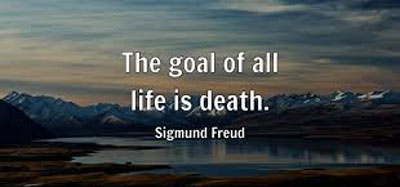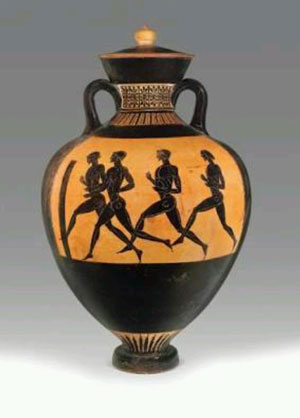|
Crystal Moment
Robert Peter Tristram Coffin
Once or twice this side of death
Things can make one hold his breath.
From my boyhood I remember
A crystal moment in September.
A wooded island rang with sounds
Of church bells in the throats of hounds.
A buck leaped out and took the tide
With jewels flowing past each side.
With his head high like a tree
He swam within a yard of me.
I saw the golden drop of light
In his eyes turned dark with fright.
I saw the forest’s holiness
On him like a fierce caress.
Fear made him lovely past belief,
My heart was trembling like a leaf.
He leans towards the land and life
With need above him like a knife.
In his wake the hot hounds churned
They stretched their muzzles out and yearned.
They bayed no more, but swam and throbbed
Hunger drove them till they sobbed.
Pursued, pursuers reached the shore
And vanished. I saw nothing more.
So they passed, a pageant such
As only gods could witness much,
Life and death upon one tether
And running beautiful together.
You want to write a poem about a memorable experience you had as
a child. You were swimming near a wooded island. You heard baying
sounds approaching its shore. Suddenly a buck leaped into the water,
pursued by hounds. As it swam past it was so close that you could see the
gleam in its eye. Both deer and hounds swam as if their lives depended
upon it until they reached the mainland and disappeared. You were deeply
affected by this experience which you’ve been mulling over for years, and
now you are ready to write about it.
Entitled “Crystal Moment,” Coffin’s poem is actually a progressive series of
riveting sub-moments, leading to a momentous finale. Our poet wants you
to hear, see, viscerally feel what happened, and he chooses the perfect
poetic form to intensify your interest.
A buck leaped out and took the tide
With jewels flowing past each side.
In his wake the hot hounds churned.
They stretched their muzzles out and yearned.
Coffin’s short, rhymed tetrameter couplets, focus us on each “moment” of
the drama as it evolves. Each couplet takes just 3 to 4 seconds to read,
creating the impression that what we are experiencing imaginatively is
happening in real time.
As compelling as this story is we must not forget that the speaker is an
adult describing what happened to him as a child. Coffin acknowledges this
with language that oscillates between capturing boyhood versus adult states
of mind. The basic diction and cliché simile “With his head high like a tree”
is something a child might say, as is “My heart was trembling like a leaf.”
Although readers may have heard those similes many times before, they
would feel fresh and powerful to a young boy.
And while the first line of the following stanza could also be said by a boy,
the second line is too poetic and philosophical, a better fit for a man who
has been meditating on his younger self’s experience:
“I saw the golden drop of light / In his eyes turned dark with fright” sounds
adult, as do the final two couplets where “pageant” and “witness” and
“tether” are more likely diction for a man than a boy. Coffin honors both
his mature self and his child within as he recounts what happened and
meditates on its meaning.
Writing in 1935, Coffin would certainly be aware of Wordsworth’s famous
poem “My Heart Leaps Up” which also concerns the continuity between
child and man and may have been thinking of it when he composed his
poem.
Both poets are writing about an innate, almost autonomic spiritual reaction
to a natural phenomenon. Wordsworth’s heart “leaps up.” The rainbow
makes him feel that all is right with the world, although he does not go as
far as Browning’s Pippa will do with her “God’s in his Heaven, / All’s right
with the world.” Wordsworth calls the awe and wonder he feels “natural
piety” to distinguish it from the artificial reverence organized religions
inculcate. His response to the beauty of rainbows, both as child and adult,
reminds him that “The Child is father to the Man.” Our early experiences
nurture and unify adult consciousness.
Coffin takes Wordsworth’s natural piety into darker territory. His child is
also father to his man, but his natural piety erupts as he observes a life and
death struggle for survival. Wordsworth’s heart “leaps up” at the sight of a
rainbow. Coffin’s heart trembles upon witnessing fear in the eyes of a stag,
and we tremble with him. All is not right with the world.
Yet surprisingly, Coffin’s adult admits to experiencing what the child may
have experienced subconsciously: that the fear in the stag’s eye feels “lovely
past belief.” As long as the animal is alive the holiness of the forest that
nurtured him and brought him to maturity remains upon him “like a fierce
caress.”
“Rainbow, rainbow, rainbow,” I hear Elizabeth Bishop protest, as she tosses
the amazing fish she so lovingly described back into the water. But Coffin’s
child is powerless to intervene on behalf of the stag because he is
witnessing nature’s firmest, undeniable structural principle. In Freud’s
words:

Coffin bravely explores what Wordsworth ignores by demanding nothing
less than full natural piety in response to that reality.
The apparent oxymoron that begins the poet’s story can momentarily pull
the rug out from under us:
How, we might wonder, can the sound of baying in “the throats of hounds”
be said to be like “church bells”? Well, church bells can call us to prayer,
but they can also be a knell, calling us to a mass for the dead, and the
hounds are trying their best to kill the stag.
Without death life would have become unsustainable on our planet long
before we arrived. Nature’s “fierce caress” brilliantly celebrates a process
that is both loving and savage, necessary and benevolent. It allows every
creature to have its moment in life’s “pageant,” without preventing future
creatures from having theirs.
Though this implacable law might seem grim, Coffin’s poem is a marvelous
tribute to the power, vigor, and persistence of life. Death does not yet have
dominion here. The island rings with sounds. The magnificent buck leaps
out and takes the tide. The bubbles he creates look like jewels. The hounds
churn, throb, yearn, and stretch their muscles, hunger driving them till
they sob. The boy holds his breath and feels his heart beating, as he
experiences the wonder and terror of being alive.
Still, it’s easier to find beauty in a rainbow than in the universal struggle
between life and death—unless, like a god, you have created that struggle.
As he introduces his final “crystal moment” our poet admits that we would
have to be godlike to dwell “much” on what we’ve witnessed. The gods,
after all, are immortal. Like the stag, the hounds, like all living creatures,
we too are caught in time’s net:
So they passed, a pageant such
As only gods could witness much,
Life and death upon one tether
And running beautiful together.
In the poem’s final “crystal moment” a terrible beauty is born as the poet
accepts the unalterable law that encompasses him. As to why life and death
run beautiful together, Coffin might point to Keats’ Ode on a Grecian Urn
and its enigmatic conclusion that “Beauty is truth, truth beauty—that is “all
/ Ye know on earth and all ye need to know.”

The figures pursuing love and life on Keats’ urn once had their magical
“moment” on earth even as we are now experiencing ours. Coffin’s final
couplet certainly lives up to the promise of his title. It is crystal clear. And it
is beautiful.
Note
: Robert Peter Tristram Coffin was born March 18, 1892 in Brunswick,
Maine and died January 20, 1955 in Portland, Maine. “Crystal Moment”
first appeared in his collection Strange Holiness which earned him a
Pulitzer Prize in 1936.
|